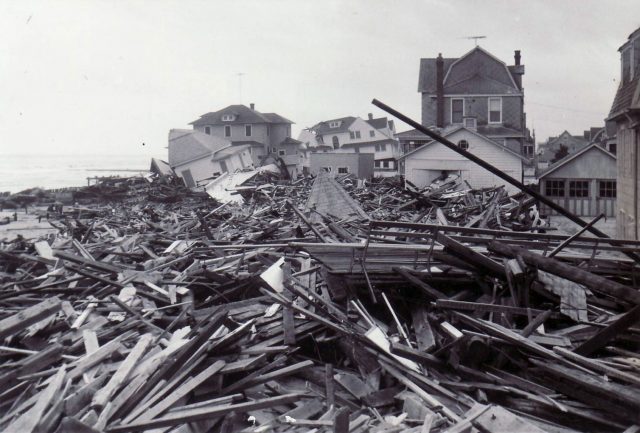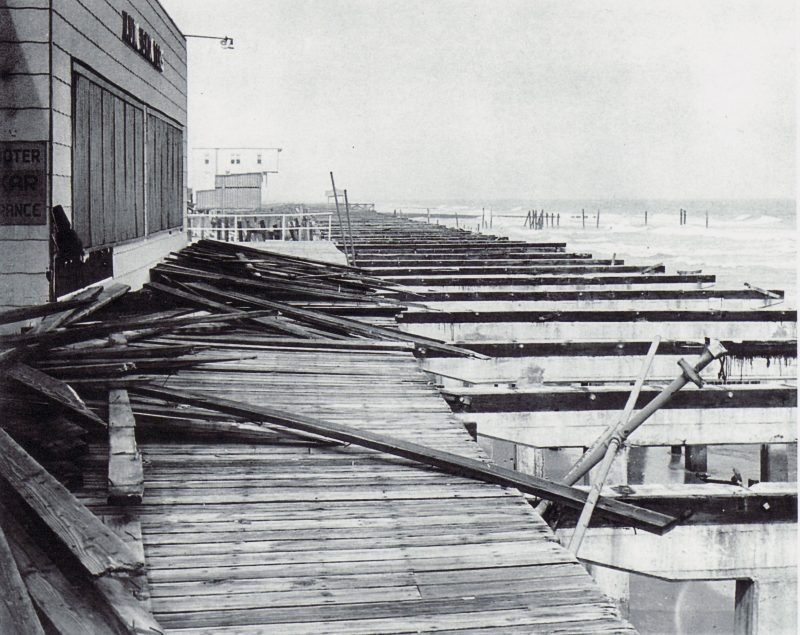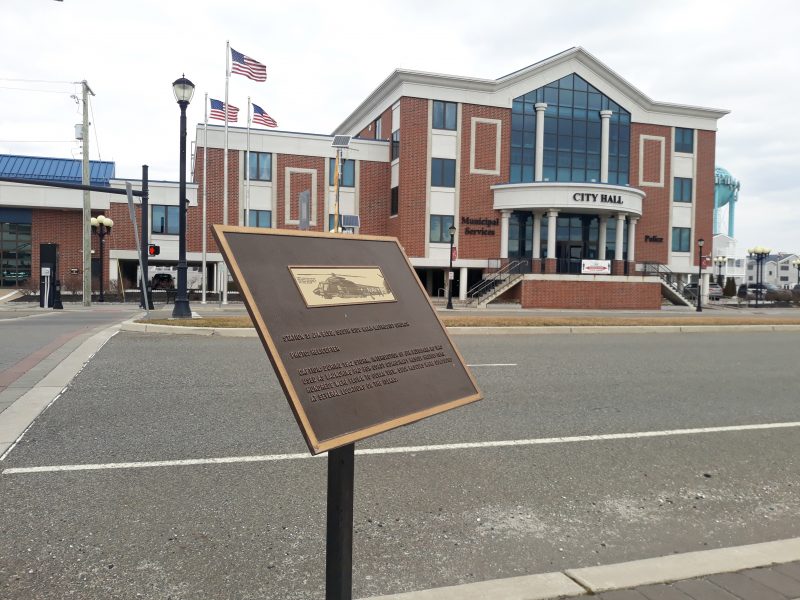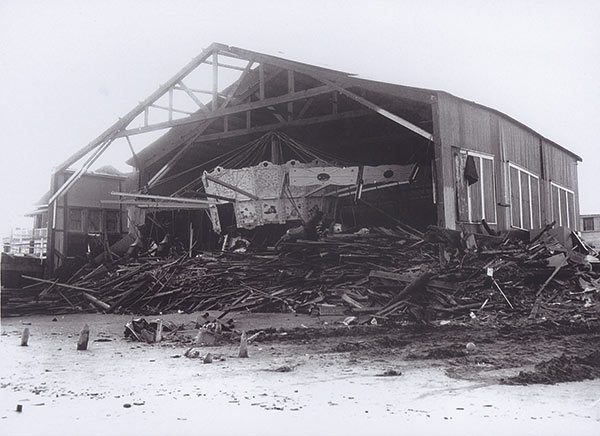
By DONALD WITTKOWSKI
It defies logic to think that homes, hotels, theaters, amusement piers and boardwalks could disappear overnight.
But they did, along with so much more, when a monstrous storm struck the Jersey Shore on March 6-8, 1962, and became Mother Nature’s version of a wrecking ball – obliterating so many landmarks that it forever changed the landscape.
In Sea Isle City, there were horrifying images of homes being swept off their foundations and floating down the street, a movie theater being buffeted by raging waves before it collapsed into the ocean and beach sand carried so far inland that it clogged the main drag of Landis Avenue.
“So much was destroyed,” recalled Joseph LaRosa Jr., who witnessed the storm as an 8-year-old boy growing up in Sea Isle and would later chronicle the devastation in two books, “Our Perfect Storm” and “Storm Stories: An Oral History.”
Now 67 years old, LaRosa said all of his favorite haunts as a kid “simply disappeared” in the storm’s fury, among them a miniature golf course, a hot dog business, the Fean Hotel and a popular carousel where he loved grabbing the brass ring.
LaRosa, a retired educator, grew up with his brother, Pat, in a home on 43rd Street and Central Avenue owned by their late parents, Joseph Sr. and Alice LaRosa. His father worked as the assistant superintendent of Sea Isle City’s Public Works department and was well known in town.
On the 59th anniversary on what became known as the Ash Wednesday Storm, LaRosa and other longtime Sea Isle residents shared their memories of the epic three-day nor’easter that ravaged the beach town but ultimately brought it together in a collective effort to rebuild the community.
The Boardwalk served as the defining symbol of the storm’s wrath. The oceanfront walkway, the epicenter of Sea Isle’s tourism trade, was reduced to twisted and mangled bits of wood rubble.

Realizing the vulnerability of having a wood structure so close to the powerful waves, the city replaced what little was left of the Boardwalk with the asphalt and concrete Promenade walkway that stands today.
“When we got up in the morning, the Boardwalk was gone and the debris covered Pleasure Avenue,” Angel Dalrymple remembered of 1962.
The now 75-year-old Dalrymple, whose family owns Sea Isle’s venerable Dalrymple’s Card & Gift Shoppe, said the storm’s destruction seemed surreal as she saw “one thing go down after another.”
Among other landmarks that were lost to the storm’s surging waves, howling winds and flooding that was 4 or 5 feet deep were the Excursion House, the Windsor Hotel, the Madeline Theater and the Sisters of Mercy Convent, along with much, much more.
A high school junior at the time, Dalrymple recalled the sense of excitement she had as a teenager when the storm arrived. Along with some of her friends, she slipped inside the oceanfront Madeline Theater and sat in the seats in the back of the building as it literally swayed back and forth while being pummeled by waves.
“The building was going side to side. You could see the humongous waves,” she said. “It was unbelievable. The next day, the building was gone.”
Although the downstairs was flooded, Angel Dalrymple’s family home at 4113 Pleasure Avenue, owned by her late parents, Charles and Angela Dalrymple, survived the storm. But like hundreds of other Sea Isle residents, Angel Dalrymple was forced to flee the storm in Navy and Coast Guard helicopters that airlifted them to safety on the mainland.
A commemorative plaque overlooking John F. Kennedy Boulevard, across the street from City Hall, marks one of the three places in town that were used as landing and takeoff spots for the rescue helicopters.

David Farina, now 76 years old and an owner of the Sea Isle real estate firm Farina & Boeshe, recalled that the most “terrifying” experience for him during the storm was the helicopter ride.
“I had never flown in a helicopter, let alone a Coast Guard helicopter,” he said.
Then a 17-year-old high school senior, Farina and his family lived by the bay at 44th Street. Their home was inundated with a foot of water on the first floor and they had to get out.
Farina was a player on the Ocean City High School basketball team. When the storm hit, it was on the same day that his team was supposed to play in a tournament game in Camden.
After his rescue helicopter landed on the mainland, Farina, much to his surprise, was greeted by his basketball coach, Dixie Howell. The now-deceased Howell, who later went on to become a legendary figure in Ocean City athletics, told Farina that they were still going to the playoff game, so they jumped into a car and drove to Camden.
“We got murdered,” Farina recounted with a laugh about his team’s lopsided playoff loss.
To this day, Farina believes that Howell pulled some strings to get him aboard the rescue helicopter in time to make the playoff game. He said Howell had connections with the commanding officer of the Coast Guard training center in Cape May.
“He would never confirm it,” Farina said of Howell’s apparent role in the helicopter ride. “But he would have done it for anybody who he coached.”

Although Farina can look back in amusement at his helicopter flight, there are other memories about the storm that still disturb him nearly 60 years later.
Many homes were ruined, nothing more than “stacks of lumber” or brick rubble, he said. Some of the homes completely disappeared.
“It was like something I never saw before and hope to never see again. I’ll never forget it,” Farina said.
Mary Jane Gleeson, then Mary Jane Mazzella, experienced the storm as a 12-year-old girl. Her late parents, Silverio and Josephine Mazzella, were the owners of the former Mazzella’s Italian Bakery at the corner of 50th Street and Landis Avenue.
The three-story building that doubled as the Mazzella family’s home and bakery still stands today. Gleeson said her father built it in 1953 as strong as a “monument,” and that was proved when it survived the 1962 storm.
However, Gleeson, now 71, remembered that a huge amount of sand was washed off the beach and carried inland onto Landis Avenue in front of their house. Sand was piled as high as the first floor windows of the bakery. The family had only a small pathway through the sand to enter their home.
“The stench was unforgettable. The smell was so strong,” Gleeson said of the churned up beach sand.
Along with her family, Gleeson was safely airlifted out of Sea Isle. They temporarily moved to New York City to live with relatives. It was a month before they could return home to the storm-devastated Sea Isle.

Joseph LaRosa Jr., who was also airlifted out of Sea Isle, said the town was left all alone to recover from the storm. It was later that the Federal Emergency Management Agency and federal flood insurance programs were established to help towns rebuild from such a catastrophic natural disaster.
Despite what may have seemed like an insurmountable challenge at that time, the residents pulled together as a community to clean up and rebuild Sea Isle, LaRosa explained.
Large swaths of undeveloped city-owned land were sold off to help fund Sea Isle’s cleanup and reconstruction.
“Everybody pitched in together and we took care of each other,” LaRosa said. “Everybody picked ourselves up by the boot straps and said, ‘Damn it, our town got knocked down and we have to fix it.’”







